Economics and Finance Report: Financial Analysis and Strategies
VerifiedAdded on 2019/11/08
|12
|2114
|154
Report
AI Summary
This report provides a comprehensive analysis of a capital investment project, focusing on financial details and strategic planning. It begins by defining and describing key aspects of investment, including capital expenditures, raw materials, and cash for operations. The report then presents detailed financial projections, including profit and loss statements, cost projections, and cash flow analysis, alongside the calculation of Internal Rate of Return (IRR). Furthermore, it identifies and assesses potential opportunities and threats associated with the investment, using a smart watch manufacturing company as a case study, and proposes actions to mitigate identified risks. Finally, the report outlines operating plans and strategies essential for the success of a manufacturing business venture, emphasizing the importance of budget alignment with corporate strategy, strategic resource allocation, performance incentives, budget flexibility, and simplicity.
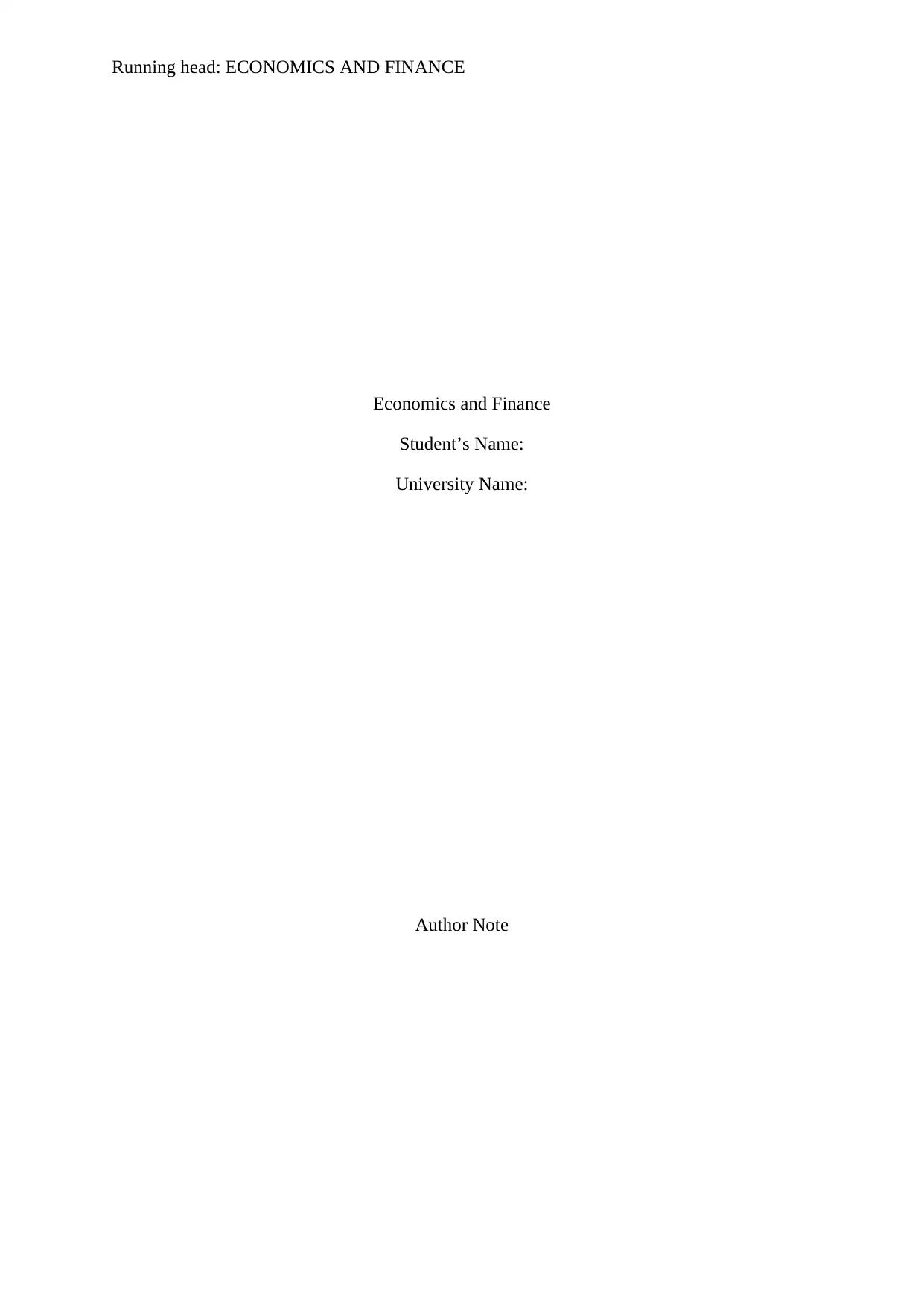
Running head: ECONOMICS AND FINANCE
Economics and Finance
Student’s Name:
University Name:
Author Note
Economics and Finance
Student’s Name:
University Name:
Author Note
Paraphrase This Document
Need a fresh take? Get an instant paraphrase of this document with our AI Paraphraser
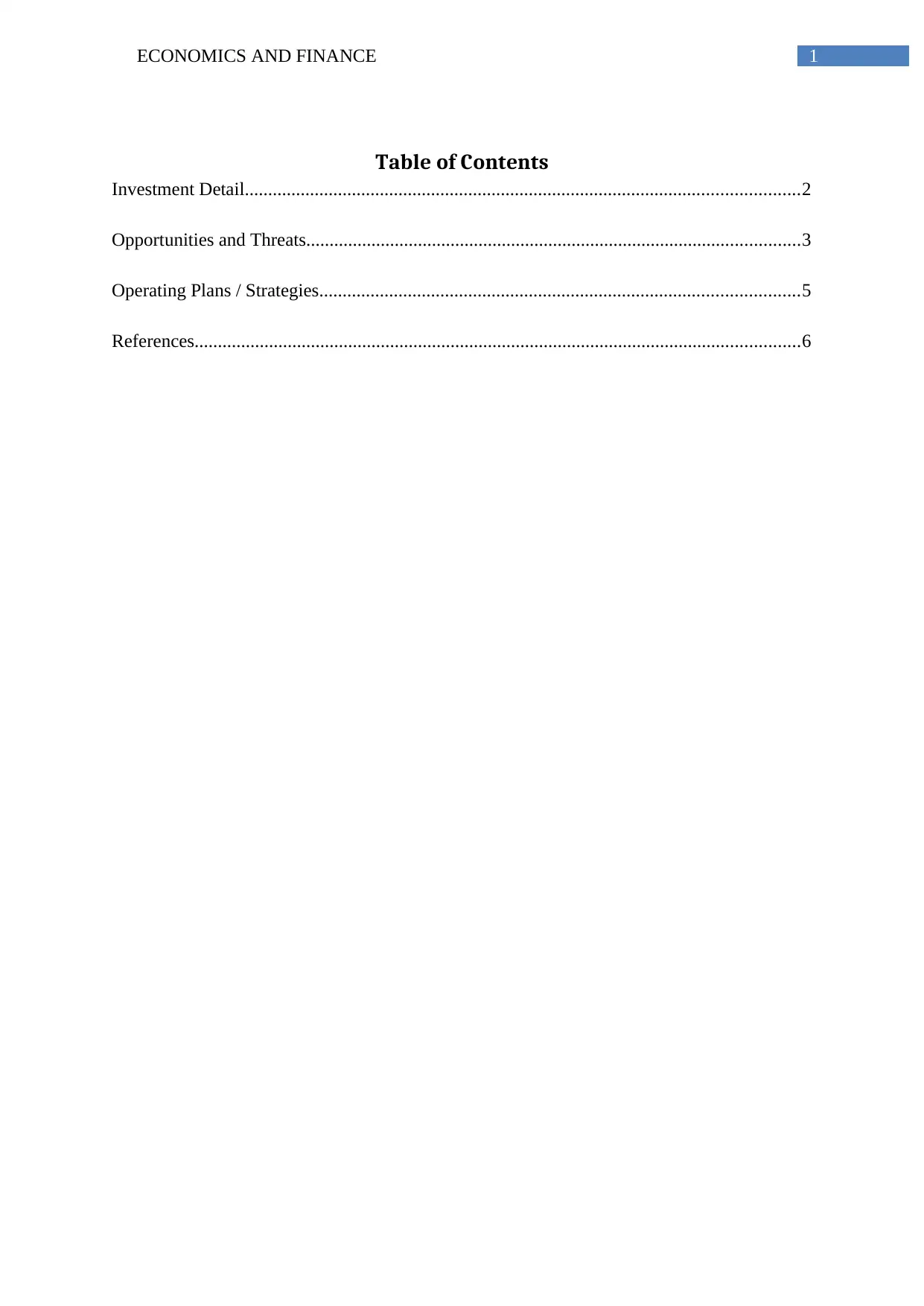
1ECONOMICS AND FINANCE
Table of Contents
Investment Detail.......................................................................................................................2
Opportunities and Threats..........................................................................................................3
Operating Plans / Strategies.......................................................................................................5
References..................................................................................................................................6
Table of Contents
Investment Detail.......................................................................................................................2
Opportunities and Threats..........................................................................................................3
Operating Plans / Strategies.......................................................................................................5
References..................................................................................................................................6
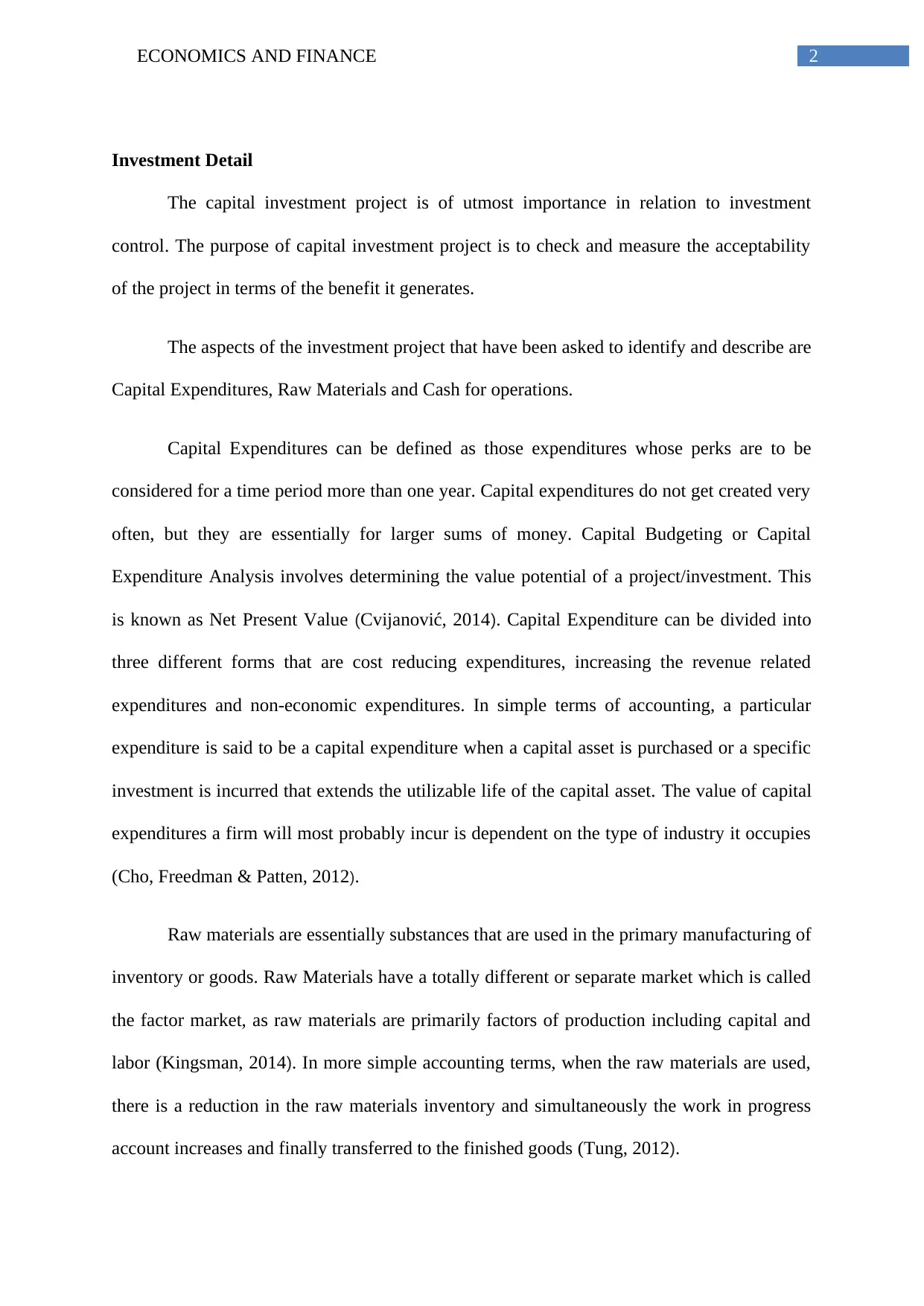
2ECONOMICS AND FINANCE
Investment Detail
The capital investment project is of utmost importance in relation to investment
control. The purpose of capital investment project is to check and measure the acceptability
of the project in terms of the benefit it generates.
The aspects of the investment project that have been asked to identify and describe are
Capital Expenditures, Raw Materials and Cash for operations.
Capital Expenditures can be defined as those expenditures whose perks are to be
considered for a time period more than one year. Capital expenditures do not get created very
often, but they are essentially for larger sums of money. Capital Budgeting or Capital
Expenditure Analysis involves determining the value potential of a project/investment. This
is known as Net Present Value (Cvijanović, 2014). Capital Expenditure can be divided into
three different forms that are cost reducing expenditures, increasing the revenue related
expenditures and non-economic expenditures. In simple terms of accounting, a particular
expenditure is said to be a capital expenditure when a capital asset is purchased or a specific
investment is incurred that extends the utilizable life of the capital asset. The value of capital
expenditures a firm will most probably incur is dependent on the type of industry it occupies
(Cho, Freedman & Patten, 2012).
Raw materials are essentially substances that are used in the primary manufacturing of
inventory or goods. Raw Materials have a totally different or separate market which is called
the factor market, as raw materials are primarily factors of production including capital and
labor (Kingsman, 2014). In more simple accounting terms, when the raw materials are used,
there is a reduction in the raw materials inventory and simultaneously the work in progress
account increases and finally transferred to the finished goods (Tung, 2012).
Investment Detail
The capital investment project is of utmost importance in relation to investment
control. The purpose of capital investment project is to check and measure the acceptability
of the project in terms of the benefit it generates.
The aspects of the investment project that have been asked to identify and describe are
Capital Expenditures, Raw Materials and Cash for operations.
Capital Expenditures can be defined as those expenditures whose perks are to be
considered for a time period more than one year. Capital expenditures do not get created very
often, but they are essentially for larger sums of money. Capital Budgeting or Capital
Expenditure Analysis involves determining the value potential of a project/investment. This
is known as Net Present Value (Cvijanović, 2014). Capital Expenditure can be divided into
three different forms that are cost reducing expenditures, increasing the revenue related
expenditures and non-economic expenditures. In simple terms of accounting, a particular
expenditure is said to be a capital expenditure when a capital asset is purchased or a specific
investment is incurred that extends the utilizable life of the capital asset. The value of capital
expenditures a firm will most probably incur is dependent on the type of industry it occupies
(Cho, Freedman & Patten, 2012).
Raw materials are essentially substances that are used in the primary manufacturing of
inventory or goods. Raw Materials have a totally different or separate market which is called
the factor market, as raw materials are primarily factors of production including capital and
labor (Kingsman, 2014). In more simple accounting terms, when the raw materials are used,
there is a reduction in the raw materials inventory and simultaneously the work in progress
account increases and finally transferred to the finished goods (Tung, 2012).
⊘ This is a preview!⊘
Do you want full access?
Subscribe today to unlock all pages.

Trusted by 1+ million students worldwide

3ECONOMICS AND FINANCE
Cash for operations or cash flow analysis is a very complex process for both investors
and companies. Cash for operations primarily refer to the monetary benefit generated by the
core or major business activities of the company. It provides a clear image of the entire
picture of the of the company’s health. Upgrading or installing new equipment and
purchasing another company, these types of activities lead companies to incur expenses
which are record as negative cash flow. Similarly, in case a company decides to sell the old
equipment, these activities are also treated as investing activities (Chen et al., 2012).
Financial Details
a. Profit and Loss Projections
Particulars Year 1
Inflation Rate
Sales Growth Rate
Sales Volume 10000
Selling Price Per Unit $3,500
Total Sales Revenue $35,000,000
Cost of Good Sold per unit:
Raw Material Consumed ($1,500)
Direct Labor Cost ($1,000)
Total Cost of Goods Sold p.u. ($2,500)
Total Cost of Goods Sold ($25,000,000)
GROSS PROFIT $10,000,000
Variable Manufacturing Overhead p.u ($650)
Total Variable Manufacturing Overhead ($6,500,000)
Depreciation on Property,Plant & Equipment ($350,000)
Cash for operations or cash flow analysis is a very complex process for both investors
and companies. Cash for operations primarily refer to the monetary benefit generated by the
core or major business activities of the company. It provides a clear image of the entire
picture of the of the company’s health. Upgrading or installing new equipment and
purchasing another company, these types of activities lead companies to incur expenses
which are record as negative cash flow. Similarly, in case a company decides to sell the old
equipment, these activities are also treated as investing activities (Chen et al., 2012).
Financial Details
a. Profit and Loss Projections
Particulars Year 1
Inflation Rate
Sales Growth Rate
Sales Volume 10000
Selling Price Per Unit $3,500
Total Sales Revenue $35,000,000
Cost of Good Sold per unit:
Raw Material Consumed ($1,500)
Direct Labor Cost ($1,000)
Total Cost of Goods Sold p.u. ($2,500)
Total Cost of Goods Sold ($25,000,000)
GROSS PROFIT $10,000,000
Variable Manufacturing Overhead p.u ($650)
Total Variable Manufacturing Overhead ($6,500,000)
Depreciation on Property,Plant & Equipment ($350,000)
Paraphrase This Document
Need a fresh take? Get an instant paraphrase of this document with our AI Paraphraser
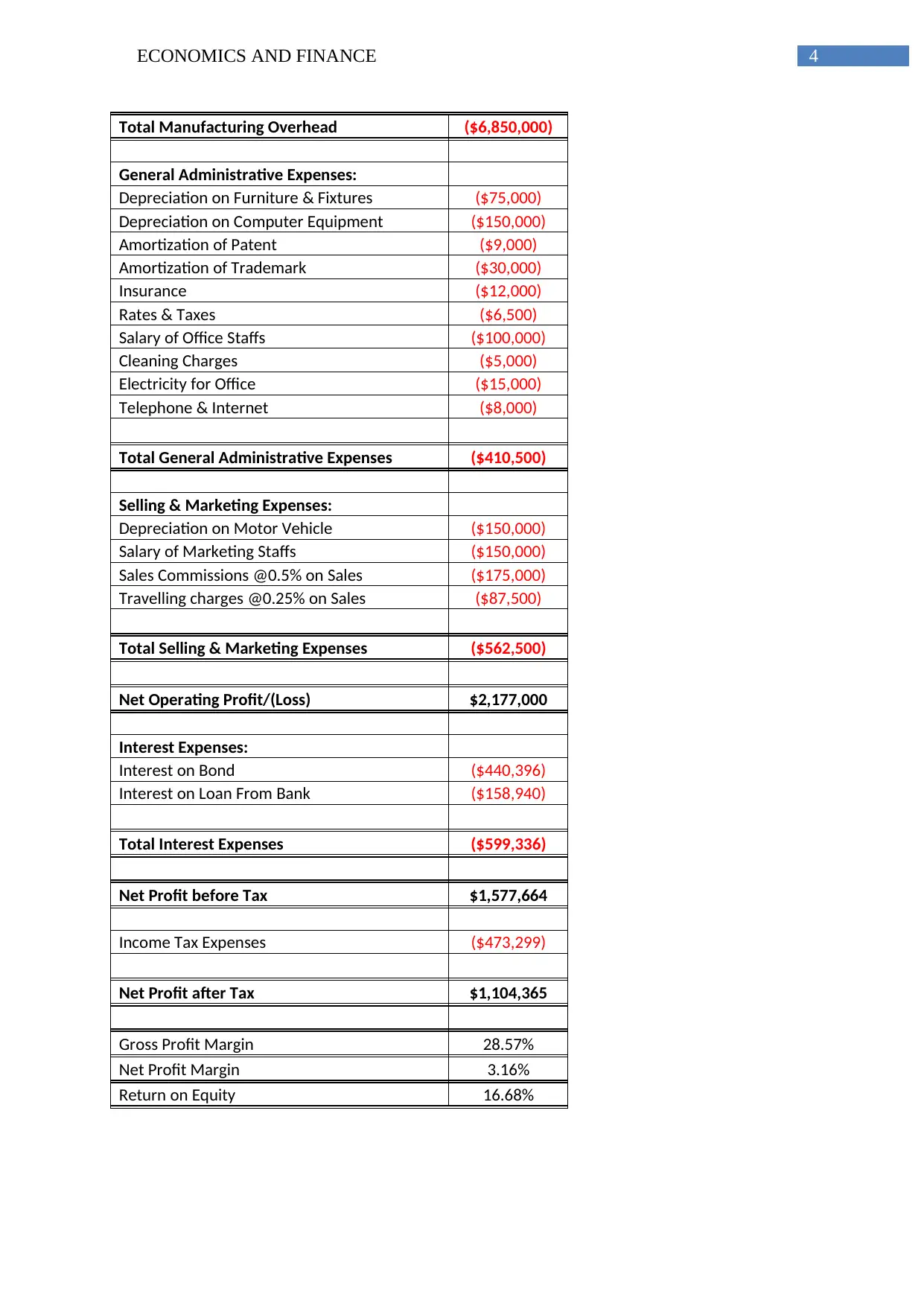
4ECONOMICS AND FINANCE
Total Manufacturing Overhead ($6,850,000)
General Administrative Expenses:
Depreciation on Furniture & Fixtures ($75,000)
Depreciation on Computer Equipment ($150,000)
Amortization of Patent ($9,000)
Amortization of Trademark ($30,000)
Insurance ($12,000)
Rates & Taxes ($6,500)
Salary of Office Staffs ($100,000)
Cleaning Charges ($5,000)
Electricity for Office ($15,000)
Telephone & Internet ($8,000)
Total General Administrative Expenses ($410,500)
Selling & Marketing Expenses:
Depreciation on Motor Vehicle ($150,000)
Salary of Marketing Staffs ($150,000)
Sales Commissions @0.5% on Sales ($175,000)
Travelling charges @0.25% on Sales ($87,500)
Total Selling & Marketing Expenses ($562,500)
Net Operating Profit/(Loss) $2,177,000
Interest Expenses:
Interest on Bond ($440,396)
Interest on Loan From Bank ($158,940)
Total Interest Expenses ($599,336)
Net Profit before Tax $1,577,664
Income Tax Expenses ($473,299)
Net Profit after Tax $1,104,365
Gross Profit Margin 28.57%
Net Profit Margin 3.16%
Return on Equity 16.68%
Total Manufacturing Overhead ($6,850,000)
General Administrative Expenses:
Depreciation on Furniture & Fixtures ($75,000)
Depreciation on Computer Equipment ($150,000)
Amortization of Patent ($9,000)
Amortization of Trademark ($30,000)
Insurance ($12,000)
Rates & Taxes ($6,500)
Salary of Office Staffs ($100,000)
Cleaning Charges ($5,000)
Electricity for Office ($15,000)
Telephone & Internet ($8,000)
Total General Administrative Expenses ($410,500)
Selling & Marketing Expenses:
Depreciation on Motor Vehicle ($150,000)
Salary of Marketing Staffs ($150,000)
Sales Commissions @0.5% on Sales ($175,000)
Travelling charges @0.25% on Sales ($87,500)
Total Selling & Marketing Expenses ($562,500)
Net Operating Profit/(Loss) $2,177,000
Interest Expenses:
Interest on Bond ($440,396)
Interest on Loan From Bank ($158,940)
Total Interest Expenses ($599,336)
Net Profit before Tax $1,577,664
Income Tax Expenses ($473,299)
Net Profit after Tax $1,104,365
Gross Profit Margin 28.57%
Net Profit Margin 3.16%
Return on Equity 16.68%

5ECONOMICS AND FINANCE
b. Cost Projections
Particulars Year 1
Inflation Rate
Sales Growth Rate
Sales Volume 10000
Cost of Good Sold per unit:
Raw Material Consumed ($1,500)
Direct Labor Cost ($1,000)
Total Cost of Goods Sold p.u. ($2,500)
Total Cost of Goods Sold ($25,000,000)
c. Cash Flow and IRR
Particulars Year 1
Cash Flow from Operating Activities:
Cash Sales $14,000,000
Collection from Debtors $19,250,000
Cash Purchase ($6,000,000)
Payment to Suppliers ($7,500,000)
Direct Labor Cost ($9,166,667)
Manufacturing Expenses ($6,500,000)
Insurance ($12,000)
Rates & Taxes ($6,500)
Salary of Office Staffs ($91,667)
Cleaning Charges ($5,000)
Electricity for Office ($13,750)
Telephone & Internet ($7,333)
Salary of Marketing Staffs ($137,500)
Sales Commissions @1.5% on Sales ($175,000)
Travelling charges @2% on Sales ($87,500)
Income Tax Expenses ($473,299)
Cash Inflow/(Outflow) from
Operating Activities $3,073,784
b. Cost Projections
Particulars Year 1
Inflation Rate
Sales Growth Rate
Sales Volume 10000
Cost of Good Sold per unit:
Raw Material Consumed ($1,500)
Direct Labor Cost ($1,000)
Total Cost of Goods Sold p.u. ($2,500)
Total Cost of Goods Sold ($25,000,000)
c. Cash Flow and IRR
Particulars Year 1
Cash Flow from Operating Activities:
Cash Sales $14,000,000
Collection from Debtors $19,250,000
Cash Purchase ($6,000,000)
Payment to Suppliers ($7,500,000)
Direct Labor Cost ($9,166,667)
Manufacturing Expenses ($6,500,000)
Insurance ($12,000)
Rates & Taxes ($6,500)
Salary of Office Staffs ($91,667)
Cleaning Charges ($5,000)
Electricity for Office ($13,750)
Telephone & Internet ($7,333)
Salary of Marketing Staffs ($137,500)
Sales Commissions @1.5% on Sales ($175,000)
Travelling charges @2% on Sales ($87,500)
Income Tax Expenses ($473,299)
Cash Inflow/(Outflow) from
Operating Activities $3,073,784
⊘ This is a preview!⊘
Do you want full access?
Subscribe today to unlock all pages.

Trusted by 1+ million students worldwide
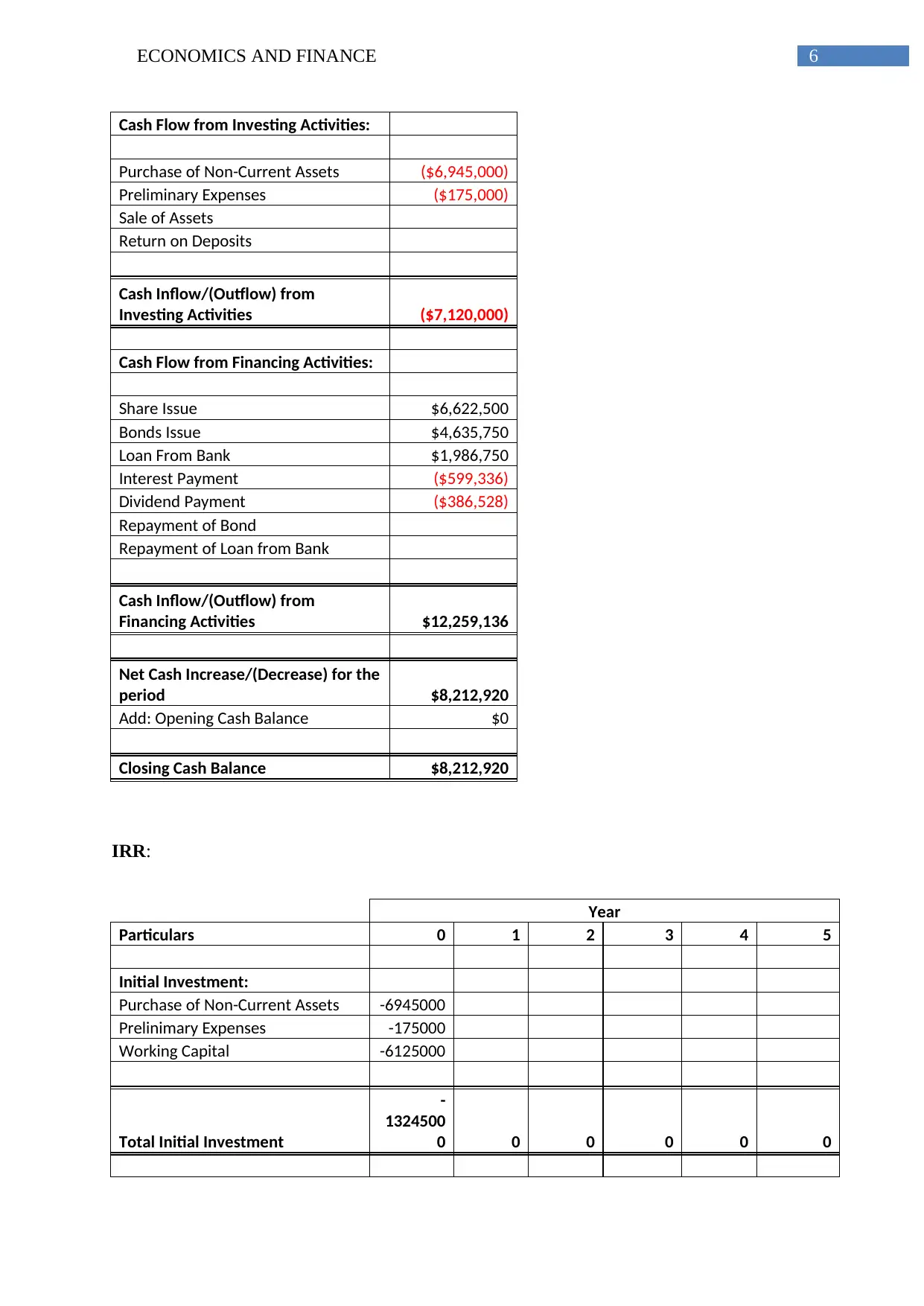
6ECONOMICS AND FINANCE
Cash Flow from Investing Activities:
Purchase of Non-Current Assets ($6,945,000)
Preliminary Expenses ($175,000)
Sale of Assets
Return on Deposits
Cash Inflow/(Outflow) from
Investing Activities ($7,120,000)
Cash Flow from Financing Activities:
Share Issue $6,622,500
Bonds Issue $4,635,750
Loan From Bank $1,986,750
Interest Payment ($599,336)
Dividend Payment ($386,528)
Repayment of Bond
Repayment of Loan from Bank
Cash Inflow/(Outflow) from
Financing Activities $12,259,136
Net Cash Increase/(Decrease) for the
period $8,212,920
Add: Opening Cash Balance $0
Closing Cash Balance $8,212,920
IRR:
Year
Particulars 0 1 2 3 4 5
Initial Investment:
Purchase of Non-Current Assets -6945000
Prelinimary Expenses -175000
Working Capital -6125000
Total Initial Investment
-
1324500
0 0 0 0 0 0
Cash Flow from Investing Activities:
Purchase of Non-Current Assets ($6,945,000)
Preliminary Expenses ($175,000)
Sale of Assets
Return on Deposits
Cash Inflow/(Outflow) from
Investing Activities ($7,120,000)
Cash Flow from Financing Activities:
Share Issue $6,622,500
Bonds Issue $4,635,750
Loan From Bank $1,986,750
Interest Payment ($599,336)
Dividend Payment ($386,528)
Repayment of Bond
Repayment of Loan from Bank
Cash Inflow/(Outflow) from
Financing Activities $12,259,136
Net Cash Increase/(Decrease) for the
period $8,212,920
Add: Opening Cash Balance $0
Closing Cash Balance $8,212,920
IRR:
Year
Particulars 0 1 2 3 4 5
Initial Investment:
Purchase of Non-Current Assets -6945000
Prelinimary Expenses -175000
Working Capital -6125000
Total Initial Investment
-
1324500
0 0 0 0 0 0
Paraphrase This Document
Need a fresh take? Get an instant paraphrase of this document with our AI Paraphraser

7ECONOMICS AND FINANCE
Net Opearting Profit before Tax 0
217700
0
250959
4 2850499
320419
4 3574794
Less: Income Tax 0 653100 752878 855150 961258 1072438
Net Operating Profit after Tax 0
283010
0
326247
3 3705649
416545
3 4647232
Add: Depreciation & Amortization 0 764000 692750
635187.
5 588659 551030
Net Operating Cash Flow 0
359410
0
395522
3 4340836
475411
2 5198263
Terminal Value:
Sale of Non-Current Assets 1125000
Recovery of Preliminary Expenses 17500
Recovery of Working Capital 6125000
Total Terminal Value 0 0 0 0 0 7267500
Net Annual Cash Flow
-
1324500
0
359410
0
395522
3 4340836
475411
2
1246576
3
Discount Rate (WACC) 8.17% 8.17% 8.17% 8.17% 8.17% 8.17%
Discounted Cash Flow
-
1324500
0
332271
7
338047
2 3429912
347282
0 8418503
IRR 16.71%
Opportunities and Threats
For the easy understanding of the opportunities and threats that are related to
venturing into an investment project, the investment in a smart watch manufacturing
company is taken into consideration (Bundy, Shropshire & Buchholtz, 2013).
OPPORTUNITIES IMPACT ON GROSS INCOME
Net Opearting Profit before Tax 0
217700
0
250959
4 2850499
320419
4 3574794
Less: Income Tax 0 653100 752878 855150 961258 1072438
Net Operating Profit after Tax 0
283010
0
326247
3 3705649
416545
3 4647232
Add: Depreciation & Amortization 0 764000 692750
635187.
5 588659 551030
Net Operating Cash Flow 0
359410
0
395522
3 4340836
475411
2 5198263
Terminal Value:
Sale of Non-Current Assets 1125000
Recovery of Preliminary Expenses 17500
Recovery of Working Capital 6125000
Total Terminal Value 0 0 0 0 0 7267500
Net Annual Cash Flow
-
1324500
0
359410
0
395522
3 4340836
475411
2
1246576
3
Discount Rate (WACC) 8.17% 8.17% 8.17% 8.17% 8.17% 8.17%
Discounted Cash Flow
-
1324500
0
332271
7
338047
2 3429912
347282
0 8418503
IRR 16.71%
Opportunities and Threats
For the easy understanding of the opportunities and threats that are related to
venturing into an investment project, the investment in a smart watch manufacturing
company is taken into consideration (Bundy, Shropshire & Buchholtz, 2013).
OPPORTUNITIES IMPACT ON GROSS INCOME
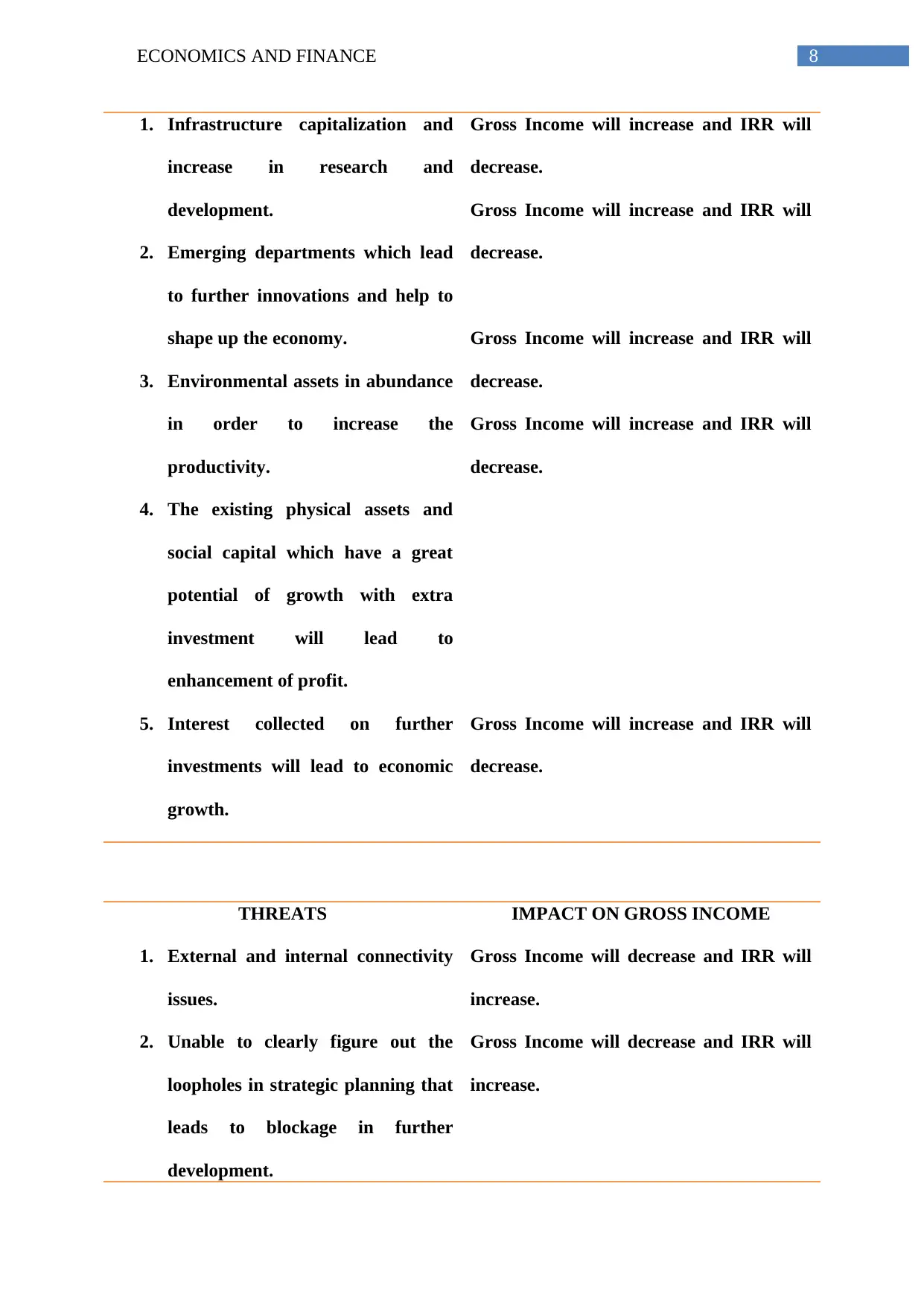
8ECONOMICS AND FINANCE
1. Infrastructure capitalization and
increase in research and
development.
2. Emerging departments which lead
to further innovations and help to
shape up the economy.
3. Environmental assets in abundance
in order to increase the
productivity.
4. The existing physical assets and
social capital which have a great
potential of growth with extra
investment will lead to
enhancement of profit.
5. Interest collected on further
investments will lead to economic
growth.
Gross Income will increase and IRR will
decrease.
Gross Income will increase and IRR will
decrease.
Gross Income will increase and IRR will
decrease.
Gross Income will increase and IRR will
decrease.
Gross Income will increase and IRR will
decrease.
THREATS
1. External and internal connectivity
issues.
2. Unable to clearly figure out the
loopholes in strategic planning that
leads to blockage in further
development.
IMPACT ON GROSS INCOME
Gross Income will decrease and IRR will
increase.
Gross Income will decrease and IRR will
increase.
1. Infrastructure capitalization and
increase in research and
development.
2. Emerging departments which lead
to further innovations and help to
shape up the economy.
3. Environmental assets in abundance
in order to increase the
productivity.
4. The existing physical assets and
social capital which have a great
potential of growth with extra
investment will lead to
enhancement of profit.
5. Interest collected on further
investments will lead to economic
growth.
Gross Income will increase and IRR will
decrease.
Gross Income will increase and IRR will
decrease.
Gross Income will increase and IRR will
decrease.
Gross Income will increase and IRR will
decrease.
Gross Income will increase and IRR will
decrease.
THREATS
1. External and internal connectivity
issues.
2. Unable to clearly figure out the
loopholes in strategic planning that
leads to blockage in further
development.
IMPACT ON GROSS INCOME
Gross Income will decrease and IRR will
increase.
Gross Income will decrease and IRR will
increase.
⊘ This is a preview!⊘
Do you want full access?
Subscribe today to unlock all pages.

Trusted by 1+ million students worldwide
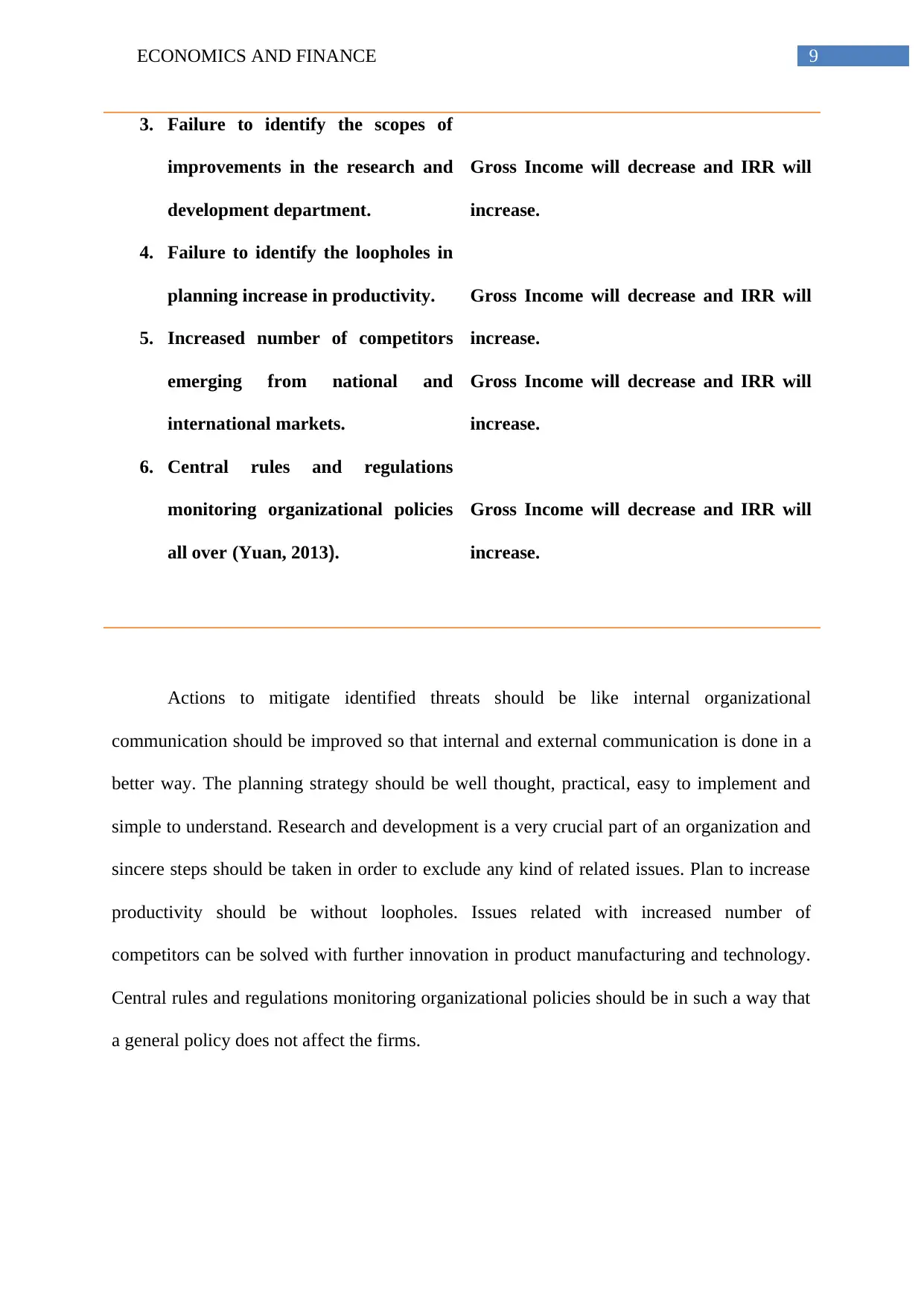
9ECONOMICS AND FINANCE
3. Failure to identify the scopes of
improvements in the research and
development department.
4. Failure to identify the loopholes in
planning increase in productivity.
5. Increased number of competitors
emerging from national and
international markets.
6. Central rules and regulations
monitoring organizational policies
all over (Yuan, 2013).
Gross Income will decrease and IRR will
increase.
Gross Income will decrease and IRR will
increase.
Gross Income will decrease and IRR will
increase.
Gross Income will decrease and IRR will
increase.
Actions to mitigate identified threats should be like internal organizational
communication should be improved so that internal and external communication is done in a
better way. The planning strategy should be well thought, practical, easy to implement and
simple to understand. Research and development is a very crucial part of an organization and
sincere steps should be taken in order to exclude any kind of related issues. Plan to increase
productivity should be without loopholes. Issues related with increased number of
competitors can be solved with further innovation in product manufacturing and technology.
Central rules and regulations monitoring organizational policies should be in such a way that
a general policy does not affect the firms.
3. Failure to identify the scopes of
improvements in the research and
development department.
4. Failure to identify the loopholes in
planning increase in productivity.
5. Increased number of competitors
emerging from national and
international markets.
6. Central rules and regulations
monitoring organizational policies
all over (Yuan, 2013).
Gross Income will decrease and IRR will
increase.
Gross Income will decrease and IRR will
increase.
Gross Income will decrease and IRR will
increase.
Gross Income will decrease and IRR will
increase.
Actions to mitigate identified threats should be like internal organizational
communication should be improved so that internal and external communication is done in a
better way. The planning strategy should be well thought, practical, easy to implement and
simple to understand. Research and development is a very crucial part of an organization and
sincere steps should be taken in order to exclude any kind of related issues. Plan to increase
productivity should be without loopholes. Issues related with increased number of
competitors can be solved with further innovation in product manufacturing and technology.
Central rules and regulations monitoring organizational policies should be in such a way that
a general policy does not affect the firms.
Paraphrase This Document
Need a fresh take? Get an instant paraphrase of this document with our AI Paraphraser
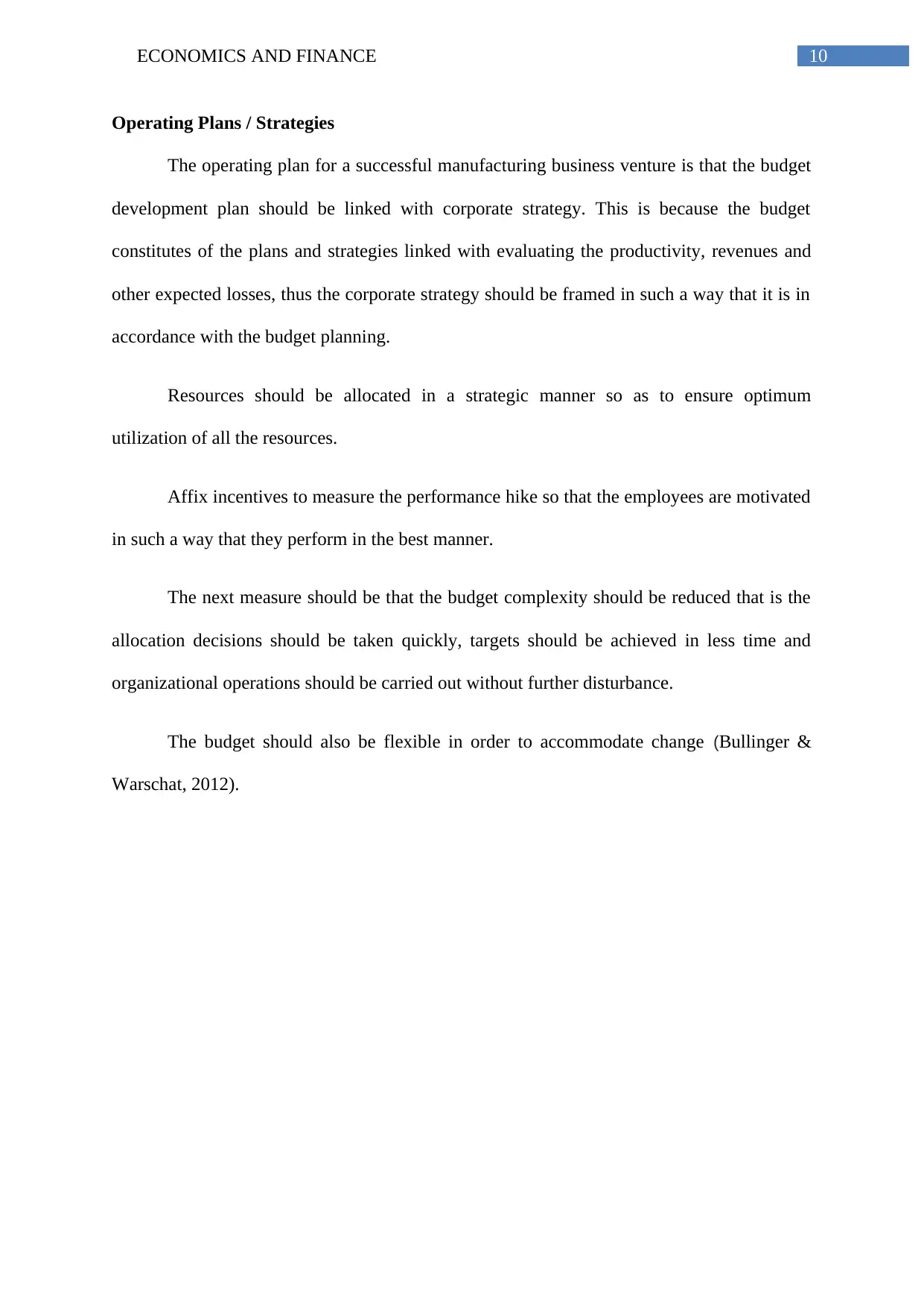
10ECONOMICS AND FINANCE
Operating Plans / Strategies
The operating plan for a successful manufacturing business venture is that the budget
development plan should be linked with corporate strategy. This is because the budget
constitutes of the plans and strategies linked with evaluating the productivity, revenues and
other expected losses, thus the corporate strategy should be framed in such a way that it is in
accordance with the budget planning.
Resources should be allocated in a strategic manner so as to ensure optimum
utilization of all the resources.
Affix incentives to measure the performance hike so that the employees are motivated
in such a way that they perform in the best manner.
The next measure should be that the budget complexity should be reduced that is the
allocation decisions should be taken quickly, targets should be achieved in less time and
organizational operations should be carried out without further disturbance.
The budget should also be flexible in order to accommodate change (Bullinger &
Warschat, 2012).
Operating Plans / Strategies
The operating plan for a successful manufacturing business venture is that the budget
development plan should be linked with corporate strategy. This is because the budget
constitutes of the plans and strategies linked with evaluating the productivity, revenues and
other expected losses, thus the corporate strategy should be framed in such a way that it is in
accordance with the budget planning.
Resources should be allocated in a strategic manner so as to ensure optimum
utilization of all the resources.
Affix incentives to measure the performance hike so that the employees are motivated
in such a way that they perform in the best manner.
The next measure should be that the budget complexity should be reduced that is the
allocation decisions should be taken quickly, targets should be achieved in less time and
organizational operations should be carried out without further disturbance.
The budget should also be flexible in order to accommodate change (Bullinger &
Warschat, 2012).
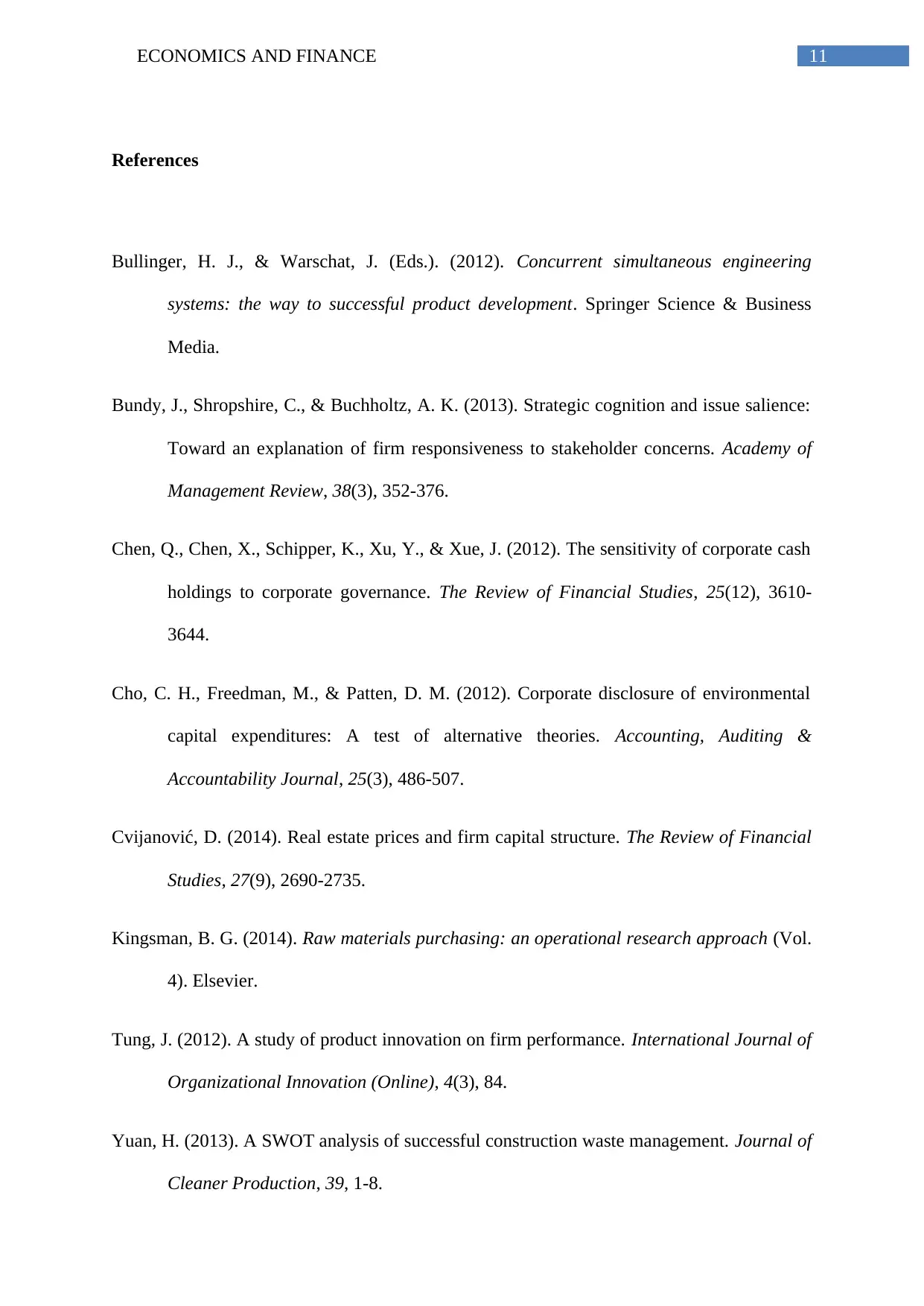
11ECONOMICS AND FINANCE
References
Bullinger, H. J., & Warschat, J. (Eds.). (2012). Concurrent simultaneous engineering
systems: the way to successful product development. Springer Science & Business
Media.
Bundy, J., Shropshire, C., & Buchholtz, A. K. (2013). Strategic cognition and issue salience:
Toward an explanation of firm responsiveness to stakeholder concerns. Academy of
Management Review, 38(3), 352-376.
Chen, Q., Chen, X., Schipper, K., Xu, Y., & Xue, J. (2012). The sensitivity of corporate cash
holdings to corporate governance. The Review of Financial Studies, 25(12), 3610-
3644.
Cho, C. H., Freedman, M., & Patten, D. M. (2012). Corporate disclosure of environmental
capital expenditures: A test of alternative theories. Accounting, Auditing &
Accountability Journal, 25(3), 486-507.
Cvijanović, D. (2014). Real estate prices and firm capital structure. The Review of Financial
Studies, 27(9), 2690-2735.
Kingsman, B. G. (2014). Raw materials purchasing: an operational research approach (Vol.
4). Elsevier.
Tung, J. (2012). A study of product innovation on firm performance. International Journal of
Organizational Innovation (Online), 4(3), 84.
Yuan, H. (2013). A SWOT analysis of successful construction waste management. Journal of
Cleaner Production, 39, 1-8.
References
Bullinger, H. J., & Warschat, J. (Eds.). (2012). Concurrent simultaneous engineering
systems: the way to successful product development. Springer Science & Business
Media.
Bundy, J., Shropshire, C., & Buchholtz, A. K. (2013). Strategic cognition and issue salience:
Toward an explanation of firm responsiveness to stakeholder concerns. Academy of
Management Review, 38(3), 352-376.
Chen, Q., Chen, X., Schipper, K., Xu, Y., & Xue, J. (2012). The sensitivity of corporate cash
holdings to corporate governance. The Review of Financial Studies, 25(12), 3610-
3644.
Cho, C. H., Freedman, M., & Patten, D. M. (2012). Corporate disclosure of environmental
capital expenditures: A test of alternative theories. Accounting, Auditing &
Accountability Journal, 25(3), 486-507.
Cvijanović, D. (2014). Real estate prices and firm capital structure. The Review of Financial
Studies, 27(9), 2690-2735.
Kingsman, B. G. (2014). Raw materials purchasing: an operational research approach (Vol.
4). Elsevier.
Tung, J. (2012). A study of product innovation on firm performance. International Journal of
Organizational Innovation (Online), 4(3), 84.
Yuan, H. (2013). A SWOT analysis of successful construction waste management. Journal of
Cleaner Production, 39, 1-8.
⊘ This is a preview!⊘
Do you want full access?
Subscribe today to unlock all pages.

Trusted by 1+ million students worldwide
1 out of 12
Related Documents
Your All-in-One AI-Powered Toolkit for Academic Success.
+13062052269
info@desklib.com
Available 24*7 on WhatsApp / Email
![[object Object]](/_next/static/media/star-bottom.7253800d.svg)
Unlock your academic potential
Copyright © 2020–2026 A2Z Services. All Rights Reserved. Developed and managed by ZUCOL.





